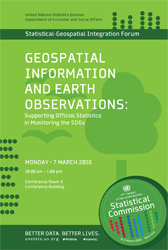United Nations Statistical Commission
47th Session (2016) Side Events
Geospatial Information and Earth Observations: Supporting Official Statistics in Monitoring the SDGs
- Monday, 7 MAR 2016
- 10:00am - 1:00pm
- Conference Room 4 (CB)
Meeting organized by UNSD
The webcast of this event will be accessible from http://webtv.un.org/
The 2030 Agenda for Sustainable Development will guide how we collectively manage and transform the social, economic and environmental dimensions of humanity and our planet over the next 15 years. Anchored by 17 Sustainable Development Goals (SDGs), 169 targets and a global indicator framework, the 2030 Agenda specifically demands the need for new data acquisition and integration approaches to improve the availability, quality, timeliness and disaggregation of data to support implementation at all levels – including to exploit the contribution to be made by a wide range of data, including Earth observations and geospatial information.
With a number of global experts providing real and practical examples, this Side Event aims to answer this question and explore the use of geospatial and Earth observation data inputs into the targets and indicators of the SDGs. It will also demonstrate how such data could be part of a comprehensive and coordinated national statistical system to monitor the state of the Earth, and to deliver timely information necessary to citizens, organizations and governments to build accountability and make good, evidenced-based decisions. Finally, through Member State case studies, experts will highlight good practices and success stories that can lead us in the right direction for a coordinated and integrated approach over the coming 15 years.
Background
As described in Goal 17 in the area of data, monitoring and accountability, there is an imperative need to “By 2020, enhance capacity-building support to developing countries, including for least developed countries and small island developing States, to increase significantly the availability of high-quality, timely and reliable data disaggregated by income, gender, age, race, ethnicity, migratory status, disability, geographic location and other characteristics relevant in national contexts.” It is clear that data, as the basis for evidence-based decision-making and accountability, will be critical to the success of the 2030 Agenda; and the global indicator framework will be the primary conduit to guide and inform Member States, based on individual national circumstances, on how they measure, monitor and report on the SDGs and related targets in the years to come.
Although the development of the global indicator framework has primarily been based on a statistical data input-output approach, as was the case for the MDGs, the need for ‘geographic location’ in a new era of data needs is well recognized. Many national statistical offices now understand that geospatial information, Earth observations and other Big Data are able to provide new and consistent data sources and methodologies to integrate multiple ‘location-based’ variables to support and inform official statistics and the indicators for the SDGs. These methods are able to fill data gaps and/or improve the temporal and spatial resolutions of data, by bringing together information from various sources, particularly those related to the environment. In this regard, the UN Global Working Group on Big Data for Official Statistics is exploring the potential of satellite imagery and geospatial data, including how to make use of existing methods for estimating official statistics and indicators for the SDGs at high temporal and spatial resolutions. Further, the report of the IAEG-SDGs to this 47th session of the Statistical Commission notes that the integration of geospatial information and statistical data will be key for the production of a number of the indicators.
-
15 minutes
Introduction and context
- Permanent Mission of Denmark to the United Nations
- Permanent Mission of Mexico to the United Nations
- Co-Chair of IAEG-SDGs
-
30 minutes
Integrating statistical and geospatial information
- Mr. David Kalisch, Australian Statistician, ABS, Australia
- Mr. Rolando Ocampo, Vice President, INEGI, Mexico
-
35 minutes
Geospatial and Earth observations data as inputs to the indicators
- Mr. Morten Møller, UN-GGIM Task Team on SDGs, Denmark
- Mr. Lawrence Friedl, GEO GI-18 SDG Implementation, United States
- Mr. Rifat Hossain, World Health Organization, Geneva
-
70 minutes
Discussion panel on national applications
- Mr. Jørgen Elmeskov, Director General, Statistics Denmark
- Mr. Pali Lehohla, Statistician-General, Statistics South Africa
- Mr. Tim Trainor, Chief Geographer, US Census Bureau, USA
- Ms. Lisa Bersales, National Statistician, Philippines
- Mr. Rolando Ocampo, Vice President, INEGI, Mexico
- Mr. David Kalisch, Australian Statistician, Australia
-
10 minutes
Summary
- Summary by Moderator to conclude
Programme Agenda
Moderator:
Mr. Greg Scott, United Nations Statistics Division
20 minutes Coffee break
